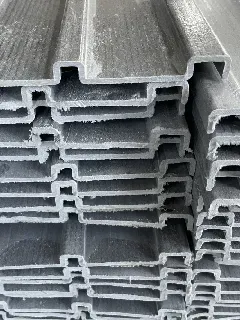loading...
- No. 9, Xingyuan South Street, Dongwaihuan Road, Zaoqiang County, Hengshui, Hebei, China
- admin@zjcomposites.com
- +86 15097380338
- Welcome to visit our website!
Innovative Solutions for FRP Roof Deck Construction and Design
The Advantages of FRP Roof Decks A Modern Solution for Roofing Needs
In recent years, the construction industry has witnessed a shift towards innovative materials that promise enhanced durability, efficiency, and sustainability. One such material gaining traction is Fiberglass Reinforced Plastic (FRP). Particularly, FRP roof decks have emerged as a robust solution for modern architecture, addressing various challenges associated with traditional roofing systems.
What is FRP?
Fiberglass Reinforced Plastic, commonly known as FRP, is a composite material made from a polymer matrix reinforced with fibers. The fibers, typically glass, provide exceptional strength and durability, making FRP an ideal choice for numerous applications, including roofing. FRP roof decks combine the lightweight characteristics of fiberglass with the strength and reliability often required in commercial and industrial roofing projects.
Benefits of FRP Roof Decks
1. Durability and Longevity One of the standout features of FRP roof decks is their ability to withstand harsh environmental conditions. Unlike traditional materials, FRP is resistant to corrosion, UV radiation, and moisture, which makes it an ideal choice for various climates. This durability translates into a longer lifespan for the roof, reducing the frequency and costs associated with replacement or extensive maintenance.
2. Lightweight Construction FRP materials are significantly lighter than traditional roofing materials such as concrete or metal. This lightweight nature can lead to lower structural costs since less support is required. Additionally, the ease of handling and installation can save time and labor costs during construction.
3. Energy Efficiency As energy efficiency becomes increasingly important in sustainable architecture, FRP roofs provide excellent thermal insulation properties. The material can help in maintaining stable indoor temperatures, reducing the need for excessive heating or cooling, and ultimately lowering energy bills.
frp roof deck

4. Design Flexibility FRP is available in various colors, textures, and finishes, offering architects and builders a high level of design flexibility. This allows for creative designs that can enhance the aesthetic appeal of a building while ensuring functionality.
5. Fire Resistance Fire safety is a critical consideration in building design, and FRP roof decks often come with fire-resistant properties. This can be crucial for buildings in areas prone to wildfires or for industries where combustible materials are present. The inclusion of fire-retardant additives within the FRP matrix can enhance safety measures.
6. Low Maintenance Requirements The inherent properties of FRP mean that these roof decks generally require minimal maintenance. Unlike traditional roofing systems that may require regular inspections and repairs due to susceptibility to rust or decay, FRP roofs can often be cleaned with simple soap and water, preserving their appearance and functionality over time.
Applications of FRP Roof Decks
FRP roof decks are increasingly being used in various sectors, including commercial, industrial, and recreational buildings. Their lightweight and durable nature makes them suitable for high-rise buildings, warehouses, and even residential applications. Furthermore, they are becoming popular in sectors where safety and hygiene are paramount, such as in food processing facilities and healthcare environments.
Conclusion
In conclusion, FRP roof decks represent a significant advancement in roofing technology, offering a range of benefits that cater to the demands of modern construction. Durability, energy efficiency, aesthetic versatility, and low maintenance requirements make FRP a compelling choice for architects and builders alike. As industries continue to prioritize sustainable building practices, the adoption of FRP roof decks is likely to grow, paving the way for a future where construction materials are both innovative and environmentally friendly. Embracing such advancements not only enhances the quality of our buildings but also contributes to a more sustainable environment.
-
The Rise of FRP Profiles: Strong, Lightweight, and Built to LastNewsJul.14,2025
-
SMC Panel Tanks: A Modern Water Storage Solution for All EnvironmentsNewsJul.14,2025
-
GRP Grating: A Modern Solution for Safe and Durable Access SystemsNewsJul.14,2025
-
Galvanized Steel Water Tanks: Durable, Reliable, and Ready for UseNewsJul.14,2025
-
FRP Mini Mesh Grating: The Safer, Smarter Flooring SolutionNewsJul.14,2025
-
Exploring FRP Vessels: Durable Solutions for Modern Fluid HandlingNewsJul.14,2025
-
GRP Structures: The Future of Lightweight, High-Performance EngineeringNewsJun.20,2025
